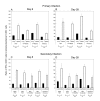Impairment of the CD8+ T cell response in lungs following infection with human respiratory syncytial virus is specific to the anatomical site rather than the virus, antigen, or route of infection
- PMID: 18816384
- PMCID: PMC2561024
- DOI: 10.1186/1743-422X-5-105
Impairment of the CD8+ T cell response in lungs following infection with human respiratory syncytial virus is specific to the anatomical site rather than the virus, antigen, or route of infection
Abstract
Background: A subset of the virus-specific CD8+ cytotoxic T lymphocytes (CTL) isolated from the lungs of mice infected with human respiratory syncytial virus (RSV) is impaired in the ability to secrete interferon gamma (IFNgamma), a measure of functionality. It was suggested that the impairment specifically suppressed the host cellular immune response, a finding that could help explain the ability of RSV to re-infect throughout life.
Results: To determine whether this effect is dependent on the virus, the route of infection, or the type of infection (respiratory, disseminated, or localized dermal), we compared the CTL responses in mice following intranasal (IN) infection with RSV or influenza virus or IN or intradermal (ID) infection with vaccinia virus expressing an RSV CTL antigen. The impairment was observed in the lungs after IN infection with RSV, influenza or vaccinia virus, and after a localized ID infection with vaccinia virus. In contrast, we observed a much higher percentage of IFNgamma secreting CD8+ lymphocytes in the spleens of infected mice in every case.
Conclusion: The decreased functionality of CD8+ CTL is specific to the lungs and is not dependent on the specific virus, viral antigen, or route of infection.
Figures


Similar articles
-
HLA-restricted CD8+ cytotoxic T lymphocyte, interferon-gamma, and interleukin-4 responses to respiratory syncytial virus infection in infants and children.J Infect Dis. 2001 Mar 1;183(5):687-96. doi: 10.1086/318815. Epub 2001 Jan 31. J Infect Dis. 2001. PMID: 11181144
-
Efficient lung recruitment of respiratory syncytial virus-specific Th1 cells induced by recombinant bacillus Calmette-Guérin promotes virus clearance and protects from infection.J Immunol. 2010 Dec 15;185(12):7633-45. doi: 10.4049/jimmunol.0903452. Epub 2010 Nov 17. J Immunol. 2010. PMID: 21084664
-
Expression of interleukin-4 by recombinant respiratory syncytial virus is associated with accelerated inflammation and a nonfunctional cytotoxic T-lymphocyte response following primary infection but not following challenge with wild-type virus.J Virol. 2005 Aug;79(15):9515-26. doi: 10.1128/JVI.79.15.9515-9526.2005. J Virol. 2005. PMID: 16014914 Free PMC article.
-
The pathogenesis of respiratory syncytial virus disease in childhood.Br Med Bull. 2002;61:13-28. doi: 10.1093/bmb/61.1.13. Br Med Bull. 2002. PMID: 11997296 Review.
-
Early-Life Respiratory Syncytial Virus Infection, Trained Immunity and Subsequent Pulmonary Diseases.Viruses. 2020 May 4;12(5):505. doi: 10.3390/v12050505. Viruses. 2020. PMID: 32375305 Free PMC article. Review.
Cited by
-
Peripheral blood T cells response in human parainfluenza virus-associated lower respiratory tract infection in children.Saudi J Biol Sci. 2020 Oct;27(10):2847-2852. doi: 10.1016/j.sjbs.2020.07.005. Epub 2020 Jul 10. Saudi J Biol Sci. 2020. PMID: 32994745 Free PMC article.
-
Protective and dysregulated T cell immunity in RSV infection.Curr Opin Virol. 2013 Aug;3(4):468-74. doi: 10.1016/j.coviro.2013.05.005. Epub 2013 Jun 25. Curr Opin Virol. 2013. PMID: 23806514 Free PMC article. Review.
-
Acute Viral Respiratory Infection Rapidly Induces a CD8+ T Cell Exhaustion-like Phenotype.J Immunol. 2015 Nov 1;195(9):4319-30. doi: 10.4049/jimmunol.1403004. Epub 2015 Sep 23. J Immunol. 2015. PMID: 26401005 Free PMC article.
-
Effects of human respiratory syncytial virus, metapneumovirus, parainfluenza virus 3 and influenza virus on CD4+ T cell activation by dendritic cells.PLoS One. 2010 Nov 29;5(11):e15017. doi: 10.1371/journal.pone.0015017. PLoS One. 2010. PMID: 21124776 Free PMC article.
-
Reining in the CD8+ T cell: Respiratory virus infection and PD-1-mediated T-cell impairment.PLoS Pathog. 2019 Jan 3;15(1):e1007387. doi: 10.1371/journal.ppat.1007387. eCollection 2019 Jan. PLoS Pathog. 2019. PMID: 30605483 Free PMC article. Review. No abstract available.
References
-
- Claassen EA, Kant PA van der, Rychnavska ZS, van Bleek GM, Easton AJ, Most RG van der. Activation and inactivation of antiviral CD8 T cell responses during murine pneumovirus infection. J Immunol. 2005;175:6597–6604. - PubMed
Publication types
MeSH terms
Substances
Grants and funding
LinkOut - more resources
Full Text Sources
Medical
Molecular Biology Databases
Research Materials

